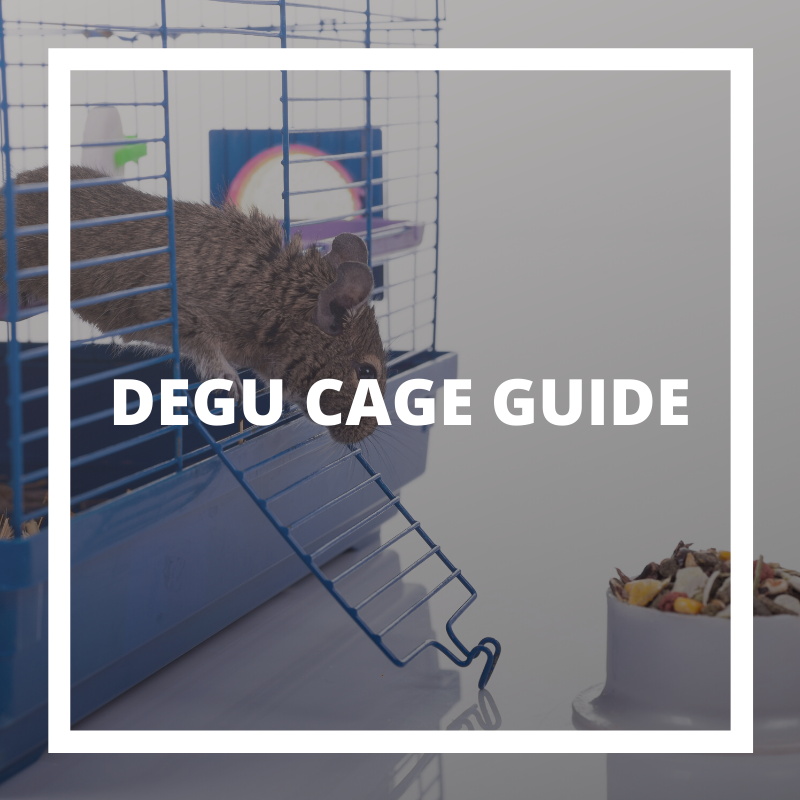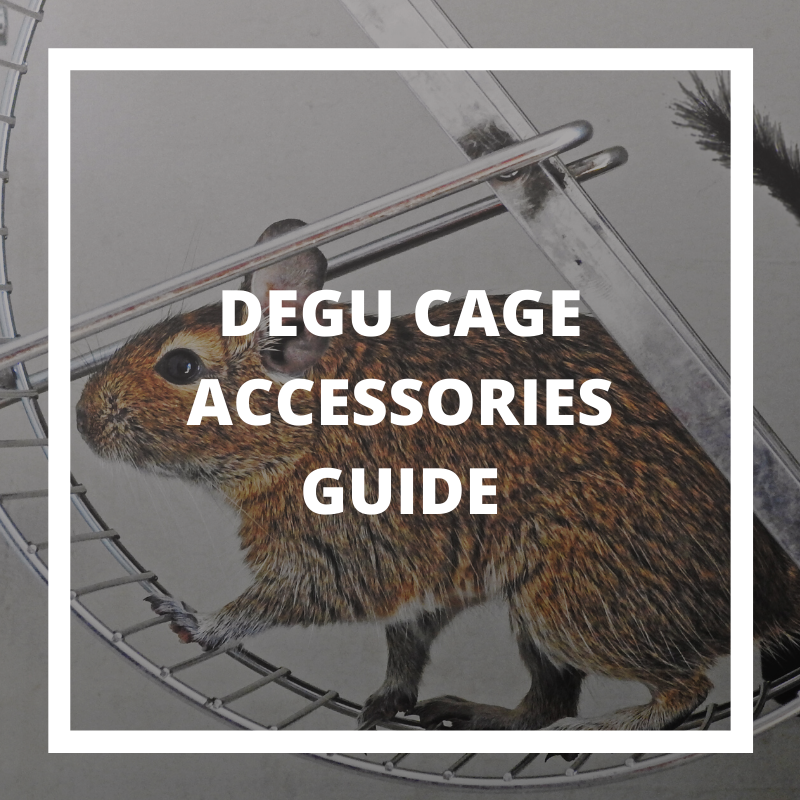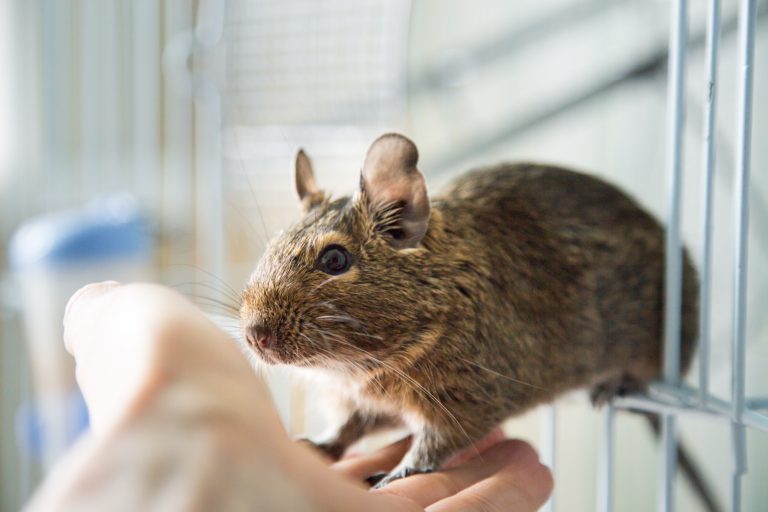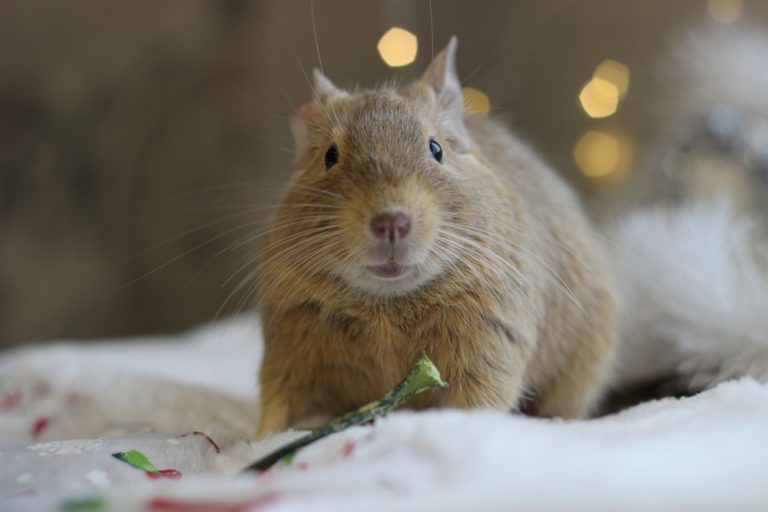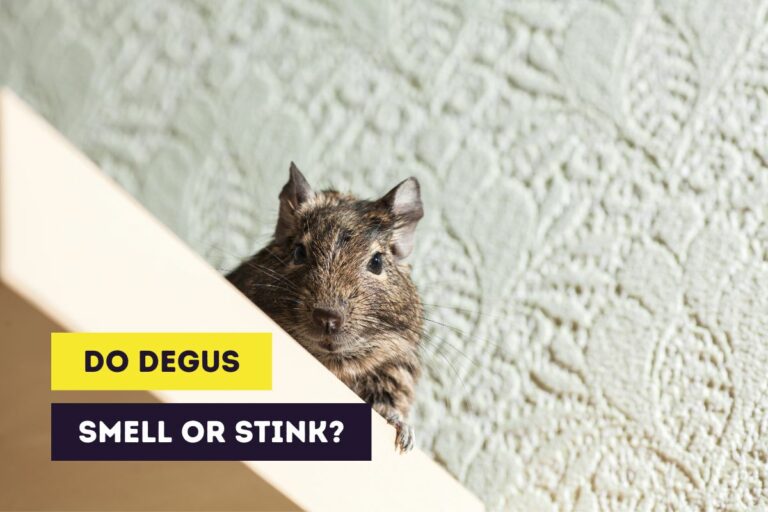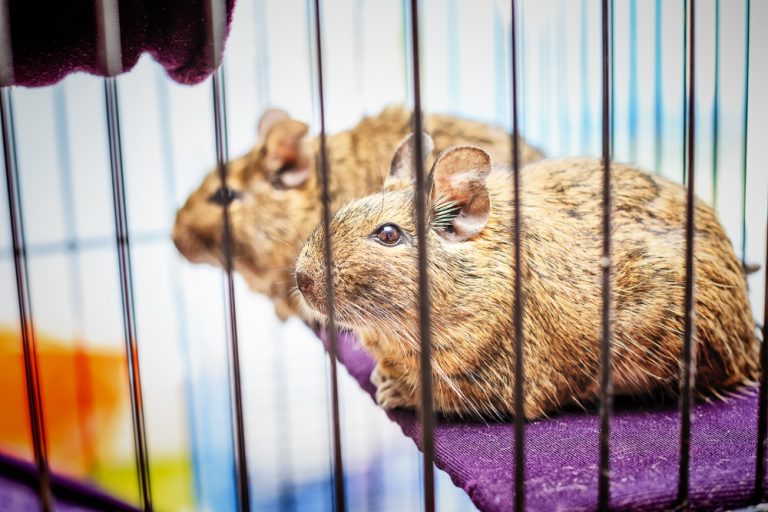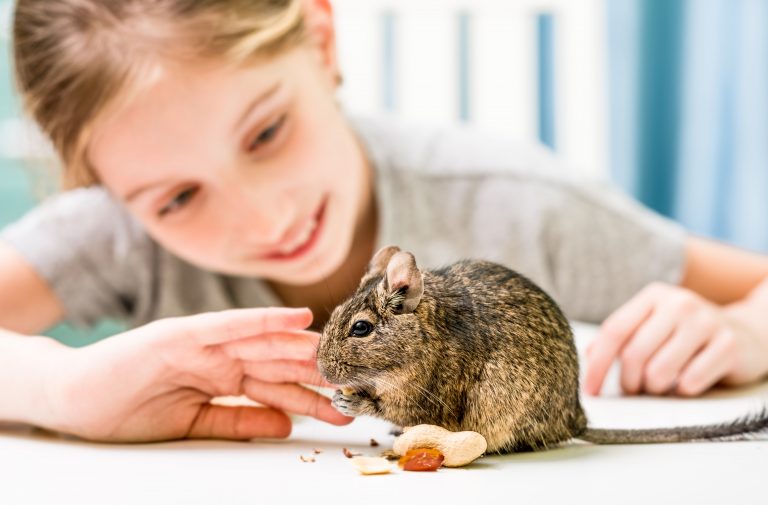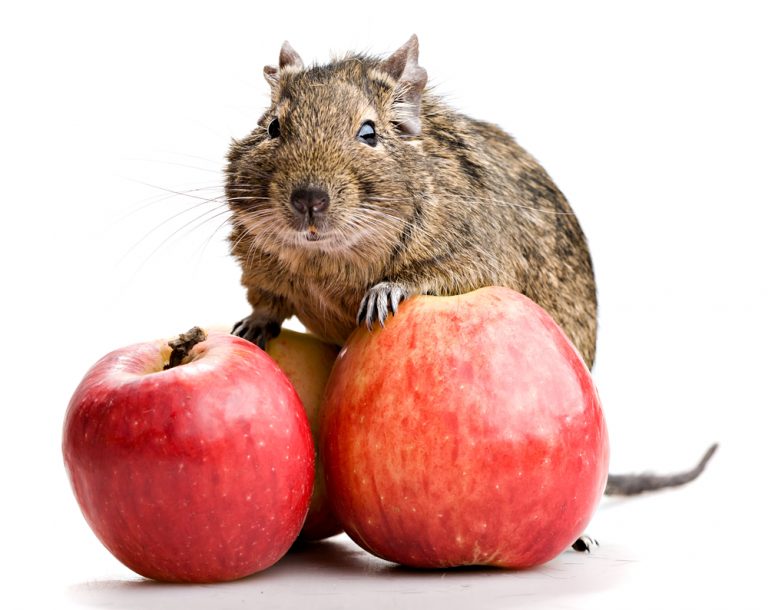Choosing the Best Bedding and Substrate for Degus
You’ve got your degu cage – if not certainly read our guide about degu cages – and now you need to get substrate to give your degus a soft surface to run on and bedding material to use for their nest. There are a lot of different substrates and bedding out there and a lot of misconceptions about what kinds are suitable for degus.
The substrate in a degu cage is a little bit like the carpet or tiles in your home. You don’t like to walk on a bare floor and your degus don’t like walking or running on a metal tray. Besides that substrate is necessary to absorb urine and to keep your degus’ cage hygienic. Bedding, on the other hand, is like the blanket on your bed, it’s necessary to keep you warm and comfy.
There are a lot of different types of substrates available online and in pet stores. Some of them are not suitable for degus and can even be a hazard for them. So you need to know to separate the good and the bad types of substrate. The same goes for the bedding.
In this article, you’ll learn exactly that. You’ll learn how to pick the right kind of substrate and bedding for your degu cage. At the end of this article, you’ll know what types of substrate and bedding are suitable for your degus and which to absolutely avoid.
This site contains affiliate links to products we recommend and use ourselves. We may receive a commission for purchases that you make through these links. If you’re interested in learning more about our affiliate links, please visit our (affiliate) disclaimer.
What’s the Difference Between Substrate and Bedding?
An empty cage needs to be lined up with soft material to make it suitable for your degus. The material that’s used for lining up the cage floor is called substrate but is sometimes mistakenly called the bedding. But there is a difference between these two terms, although it’s kind of a small difference.
What’s the use of substrate?
- keep the cage clean and hygienic
- create a soft walking area for your degus
- is used to let your degus burrow and create tunnels
- sometimes is also used as nesting material
What’s the use of bedding?
- is used as nesting material
Degu Cage Substrate Guide
What’s important when choosing a substrate?
When you look around for cage substrate you’ll need to make sure that it’s safe to use and suitable for your degus. Don’t pick just any kind of substrate you view online or in a pet store. And always consider the following important factors:
- toxicity: it’s obvious that you don’t want your degus to die. But it’s not always easy to know if the substrate is (potentially) toxic or can cause problems for your degus’ health. Avoid substrate that’s possibly harmful to your degus;
- hypoallergenic properties: a lot of people suffer from allergies but these allergies aren’t necessarily to be attributed to your pet. Substrate can contain a lot of dust that can become airborne and harm you and your degus. So, you want to choose a substrate that contains the least dust as possible;
- absorbent properties: you want your cage substrate to be absorbent so it can absorb the urine of your degus and the cage remains hygienic.
Besides these important factors, you’ll probably consider a few other less important factors that might have an influence on what kind of substrate you get:
- easy to clean: some substrate can clog and become hard when it comes in contact with urine or water. If this is the case you’ll have more work cleaning up the large and swollen substrate from the cage;
- weight of the material: there are lightweight and heavyweight substrate. If the material is lightweight it can be kicked out of the cage by your degus and end up messing up your home;
- budget: there are expensive kinds of cage substrates around but even within a certain type of substrate you can find large price differences. The cheaper substrate, however, is usually of less quality.
What kinds of cage substrate are there?
When you take a look at the substrate online or in pet stores you’ll probably be unsure what type of substrate to get. Let’s take a look at the kinds of cage substrate there is available for degus.
Wood shavings
Wood shavings are a popular substrate for a lot of animals, including rodents. It’s also possibly the oldest form of substrate for animals. Shavings are a waste product from lumber production and usually have a curly look. Wood shavings can come from different kinds of trees but most commercial wood shavings will come from pines, cedars or aspen trees.
Paper-based substrate
More recent, commercial substrate is based on (recycled) paper. These paper-based substrates come in all kinds of shapes, sizes and even colors. There are some concerns with recycled paper. They can still contain ink residues, although most paper-based substrate is safe enough to use.
Wood pulp substrate
Wood pulp substrate is related to a paper-based substrate and it’s not always as easy to make the difference between these two substrates. They have roughly the same properties and are more expensive substrate types. Wood pulp substrate is made of natural wood fibers.
Hay/Straw
Hay and straw are sometimes confused with each other. Hay is the product of cutting a plant before the plant starts producing seeds. The result is a high-quality fiber that has a high nutritional value and is used as feeding material.
Straw, on the other hand, is the stalk of the plant after the seeds have been harvested. It’s a byproduct of harvest and has little nutritional value. The value of straw lies in its use as substrate and bedding material. It’s an excellent material because it doesn’t develop mold as quickly and has a low cost.
Pellets
Wood and paper pellets are made from trees or recycled paper. The pellets look like tiny tubes and have good absorbent properties and are known for their ability to hold odors very well.
Cat litter
When you think of cat litter you probably won’t think to use it as a substrate for degus. But cat litter is a possible substrate you can find in stores and online. Cat litter is made of granulated clay or bentonite, a special kind of clay, and is known for its absorbent properties and odor-control.
What substrate to use for degu cages?
Important notice: online stores and pet stores often use the term “cage bedding” or just “bedding” to indicate substrate. Since substrate is also used as nesting material this isn’t wrong. Below I’ll go through suitable substrates for degus. Later on, I’ll get into the real bedding material.
Aspen wood shavings
Wood shavings are usually not that suitable as a substrate for your degus because they contain phenols which can be dangerous for small animals. Aspen shavings are generally considered to be safer than pine and cedar shavings. Aspen shavings are made from hardwood and are almost dust-free and are non-aromatic.
Example of aspen wood shavings: Kaytee All Natural Aspen Bedding
Wood pulp substrate
Example of wood pulp substrate: Critter Care Natural Bedding
Paper-based substrate
Example of a recycled paper substrate: CareFresh
Substrates to absolutely avoid
A lot of available substrates aren’t suitable for degus and should be avoided at all costs. Never use any of the following substrates for your degus:
- sawdust
- wooden or paper pellets
- pinewood and cedarwood shavings
- cat litter
Sawdust
Sawdust is a soft and lightweight substrate that’s definitely not suitable for degus and other small pocket pets. This substrate contains a lot of tiny dust particles that become airborne very fast. The tiny particles will end up in your degus’ lungs and will usually lead to respiratory problems. Because sawdust is such light it can also be kicked out of your degus’ cage and you’ll end up cleaning a lot.
Wooden or paper pellets
Wooden or paper pellets are relatively small but are highly absorbent. Degus will sometimes chew on their substrate and ingest parts of it. If your degus ingest pellets the pellets will swell inside their body and this can cause an obstruction of the intestinal tract. Pellets are also hard and can, just like a wire mesh floor, cause injuries to the feet of your little critters.
Pinewood and cedarwood shavings
Wood shavings from pine and cedar trees contain the following substances:
- naturally occurring phenols
- abietic (pines) or plicatic acid (cedars)
Phenols can be toxic and cause acid burns in high quantities. The phenols have a low molecular weight which makes them become airborne very easily. When they’re airborne they can be inhaled by your degus. This might lead to your degu dying in a matter of hours depending on the concentration of phenols in the shavings.
Pine trees are a species of conifer trees and contain abietic acid while cedar trees contain a unique kind of acid called plicatic acid. Both acids are the cause of skin and respiratory irritations. Plicatic acid can also worsen asthma and cause allergic reactions.
Kiln drying is a process where excess water is removed from the wood. Kiln drying is used to among other things remove phenols from the wood. However, there will still be small concentrations of phenols in the shavings. The concentration of phenols depends on a lot of different factors. Kiln drying also doesn’t remove the above-mentioned acids from the wood.
Cat litter
Cat litter is sometimes indicated as a substrate for small pets but you should never use cat litter as a substrate for your degu cage. It has high absorbent properties and can cause obstruction when ingested by your degus because the litter will swell up. The structure of cat litter is comparable to pellets and can cause injuries to the feet of your little degus.
Degu Cage Bedding Guide
What’s important when choosing bedding?
When I was talking about the important factors to take into account when choosing a substrate, I already mentioned a lot of the important factors to consider when choosing bedding or nesting material. However, there are some small differences.
In either case, you don’t want your bedding to be toxic. What’s less important is the absorbent properties of the material. Cage bedding – the real bedding, not the substrate – doesn’t cover the entire cage floor.
Some other important factors to consider when choosing cage bedding are:
- risk of internal and/or external injuries: some cage bedding can look soft and nice but can be ingested and cause impaction (digestive problems) for your degus. Sharp edges on bedding materials can also cause injuries to the feet of your degus and cloth fibers can get tangled on your degus feet or neck and cause life-threatening injuries.
- break easily and water-soluble: this factor is related to the risk of injuries. Your degus should always be able to break or chew through the bedding. When ingested the bedding should dissolve and don’t cause digestive problems.
What kinds of cage bedding are suitable for degus?
Degus love to build nests and stuff them with twigs, sticks, shavings, and any kind of material they can find in their cage. The substrates mentioned above will probably be used by your degus for their nesting boxes.
But if you want to give your degus some extra soft material to line up their sleeping areas, you can best get some bedding materials that are made for this purpose. A little warning: bedding material usually doesn’t have the same absorbent and odor-control properties as a real substrate.
Paper-based bedding
Paper-based substrate can also be used as a bedding material. You can also use shredded stripes of paper and even toilet paper as a bedding for your degus. Paper is very soft and your degus can tear it to line up their nest. You do have to make sure that you don’t use paper that contains ink as this can be toxic when ingested by your degus. Paper shreddings also are a budget option as a bedding material.
Hay
Hay is sometimes used as a bedding material but it can get mold and contain dust. Sometimes hay can also contain mites that transfer to your degus.
Fleece bedding
A lot of pictures on the internet show degu cages with fleece bedding. Fleece bedding can be used but you’ll need to make sure that you wash the fleece regularly so it doesn’t smell. If your degus don’t start chewing on the fleece they should be fine. Although it’s not my preferred type of bedding, you could give it a try yourself. Just be careful and keep an eye on your degus – and an extra eye the first days.
What bedding to avoid for degus?
There’s bedding material out there that’s not suitable for a degu. Although the bedding seems to be soft and nice it can be dangerous for your degus. Bedding can be ingested by your degus and cause digestive problems. Your degus can also get entangled in the fibers and get injured this way.
It’s wise to avoid any of the following bedding:
- cotton balls
- felt stripes
- coconut fibers
- straw (sharp edges)
Also, avoid any bedding that contains any of the following material:
- polyester stuffing
- cotton batting
Related Questions
What is the best bedding for degus?
The best bedding for degus are paper-based or wood pulp bedding. You can also create your own bedding by shredding ink-free paper or give your degus shredded (toilet) paper. Never use pine or cedar wood shavings, cat litter or sawdust as a substrate or bedding.
Can degus have sawdust?
Sawdust, not to be confused with wood shavings, contains tiny dust particles that become airborne very fast. It often causes respiratory problems for your degus and you. Sawdust is for these reasons nog suitable as a substrate or bedding and should be avoided.

